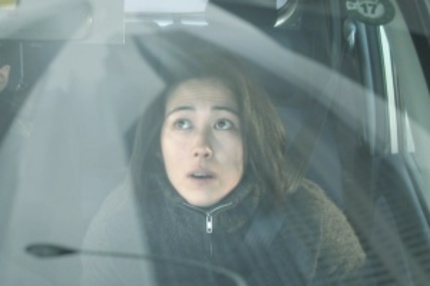Shinsedai 2010: DIFFERENT CITIES Review

Many Japanese people live in huge sprawling cities, environments which are prone to rapid change. Bar the odd museum or castle it seems like there is no sense of architectural history: complete areas are demolished and rebuilt wholesale at a fast pace.
Several films have already focused on how all this change affects the sense of place people have who live there. The first "Patlabor" movie commented on it, as did the equally excellent "TekkonKinkreet". What are your geographical "roots" worth if they constantly keep disappearing, being replaced by new structures you don't have any emotional attachment to?
In "Different Cities", video artist Kazuhiro Goshima explores similar themes. He follows different people who suddenly realize that the city they live in has changed in baffling ways. One man is unable to find his home. One woman is trying to catch her cat, only to discover that the animal took an impossible escape route. And one man is obsessed with charting the weird changes, noticing that angles and distances no longer add up properly.
While people across the city encounter impossibly high buildings and impossibly deep stairwells, an artist is concentrating on building a paper and plastic model of his perfect city. Is this work connected to the anomalies taking place?

Kazuhiro Goshima has won several awards with his short films and videoclips, and he made "Different Cities" in 2006 intentionally as an experimental artwork. Technically speaking you might call this another short perhaps, as the total running time (including credits) is only 59 minutes. Amazingly, despite being an ensemble piece which switches regularly between the several "leads" every few minutes, it feels roughly three times as long. I wouldn't exactly call it boring as patient viewers are awarded with the occasional beautiful composition or special effect, but the pacing sure is slow and doesn't build up to any sort of climax. If you expect a big revelation at the end you might be disappointed.
The film does look very nice though as the camerawork is anything but shabby. By digitally altering shots of Tokyo Goshima also manages to produce some disturbing effects: buildings look menacingly distorted and most of the time the city is totally devoid of people except for the person we happen to be following. Everything looks slick, sharp and the colors are toned down into shades of gray, even more so than the colors in the "Matrix" trilogy were.
Be warned though. This is a work of art instead of a narrative, so my advice is to treat it as such. Do not, under ANY circumstance, watch this movie while tired. The glacial pacing, the desaturated colors and the mellow music will hypnotize you to sleep if you do. My screener actively put me to sleep three evenings in a row and I was only able to finish the film by watching it in 20-minute segments, with coffee breaks in between.
Does that mean I hate the film? No. But I can only recommend it to people who like "experimental cinema" and aren't expecting a story. And perhaps can stay awake better than I do...







